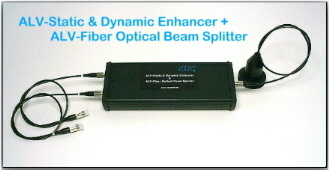

PMT or APD based “Pseudo” Cross Correlation Detectors
Whenever lag times and with this sampling time in the sub-µs regime are to be measured, computing an auto correlation function from a single detector will be distorted by afterpulsing and dead time effects. Afterpulsing, furthermore, shows the max. relative strength at small input count rates (for the simple reason that at higher count rates the probability that instead of an afterpulse a “real” signal pulse should have been generated gets larger). To overcome these problems, cross correlation is usually used. However, not every experiment is a cross correlation experiment by definition - even worse, for most experiements, no “direct” cross correlation equivalent exists. For all these experiments, “pseudo” cross correlation set-ups can be used instead. While conserving the idea of cross correlation, namely to have independency of afterpulsing of one detector to the other and thus no correlation (and the same holds true for dead time), it does not impose the difficulty of physically setting up a cross correlation experiment. In detail, a “pseudo” cross correlation detector works as follows :
- Split the incoming light into two equal light contributions of (near to) equal intensity.
- Use two single photon detectors, one illuminated by the first and the other by the second light contribution
- Use two totally de-coupled preamplifier / discriminator and pulse generation units
- Cross correlate the signal output of these two detectors instead of auto correlating each
Clearly, the resulting cross correlation function will have identical expectation to the auto correlation function, besides no longer being distorted by afterpulsing and dead times. Still, second order effects must be considered, which can be minimised only by careful selection of all parts in the detectors, from the beam splitter device to the PMTs / APDs and even the BNC cable types and length.
Two versions of “pseudo” cross correlation detectors exist, the ALV-/SO-SIPD which is a fully integrated unit with optical
beam splitter, two PMTs, fully de-coupled electronics etc. and the ALV-Fiber Optical Beam Splitter based detectors (however, fiber optical beam splitters are wavelength dependent and must be selected for a specific wavelength range). While the first unit is a general purpose unit which can be attached to virtually any optical input, has the possibility of attaching additional filters (IR, edge filters ...), the ALV-Fiber Optical Beam Splitter based detectors do in fact include the
ALV-Static&Dynamic Enhancer and thus find their use primarily as DLS&SLS detector in ALV-Compact Goniometer Systems. However, the ALV-Fiber Optical Beam Splitter based detectors are no longer limited to PMTs, but APDs can be used instead, which boost the sensitivity for red wavelength by more than a magnitude in comparison to the ALV/SO-SIPD. Furthermore, the ALV-Fiber Optical Beam Splitter based detectors are optimized for use with the ALV-7004, ALV-7004/FAST and ALV-6010-160 Digital
Correlator Series and allow the measurement at sampling and lag times as low as 5 ns with residual distortion well below the 1% range*. Please click here for a test measurement graph.
ALV Cross and “Pseudo Cross Correlation Detectors
| Dual |
Max. Counting | 30 MHz total |
Overload Protection Unit | yes, for each APD |
Dark Counts per Detector | < 250 cps, typ 200 cps |
| < 25 ns |
|
|
Beam Splitter | Fiber Optical Beam Splitter |
|
|
Q.E. at 633 nm | 70% max., typ. 65% |
Q.E. at 532 nm | 52% max., typ. 50% |
Q.E. at 488 nm | 45% max., typ. 40% |
Wavelength range | 320 nm ... 1080 nm |
|
|
Light Input | ALV-Static & Dynamic Enhancer |
Pulse Output | 2 x TTL @ 50 Ohm |
Power Requirement | 5V, 2 A (3.2 peak) |
* this may not be achievable for very low count rate situations and APD based detectors in the sub-100 ns lag time regime, because APDs tend to send out light while being in avalanche mode and this light may very well travel back to the “other” detector and trigger a photon generated pulse at some non-negligible probability. This, of course, does introduces some additional correlation, usually in the sub 100 ns lagtime regime and becomes significantly “visible” whenever very low count rates are used.
ALV reserves the right to sell the ALV-DUAL High Q.E. APD only for use with ALV-Correlators. These products must thus either be ordered in a package with an ALV-Correlator or ordered by an existing ALV-Correlator User for use with his/her ALV-Correlator.
Please inquire for special package prices !